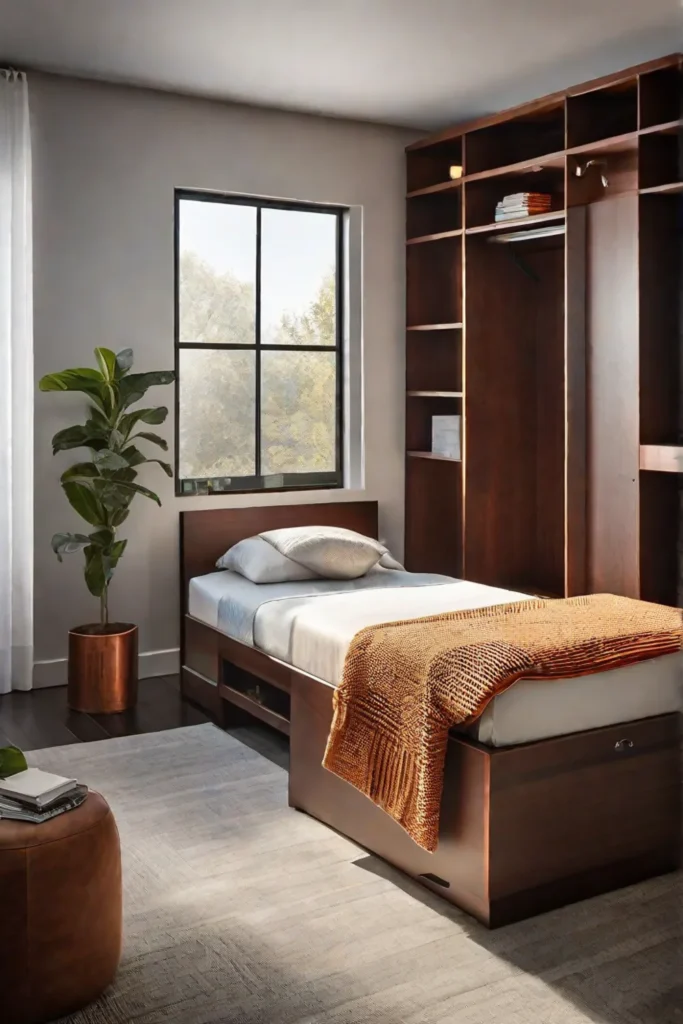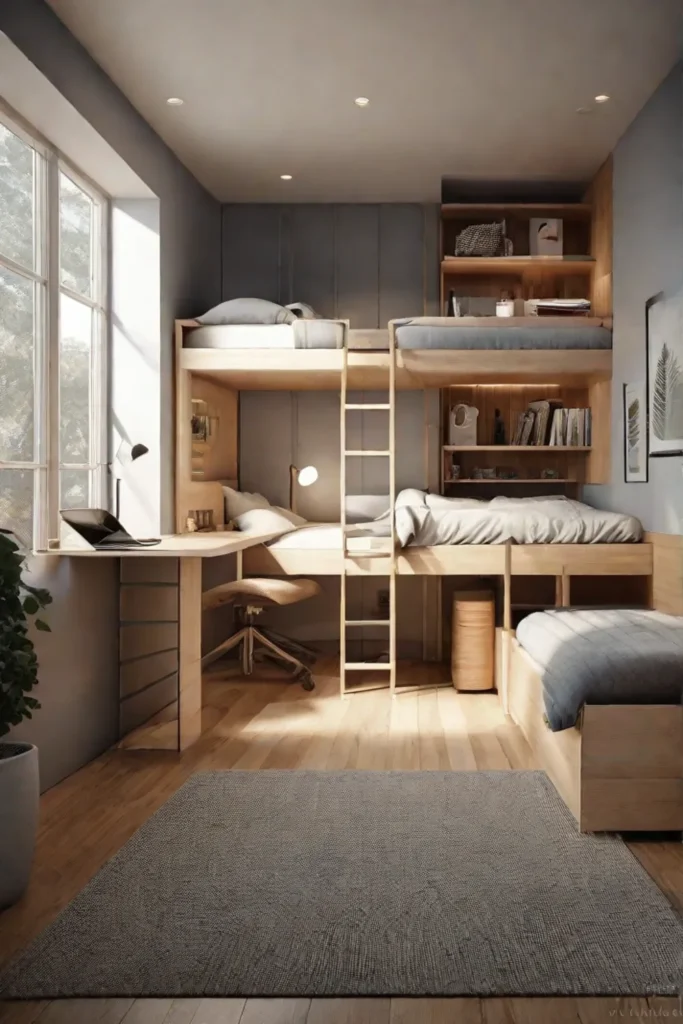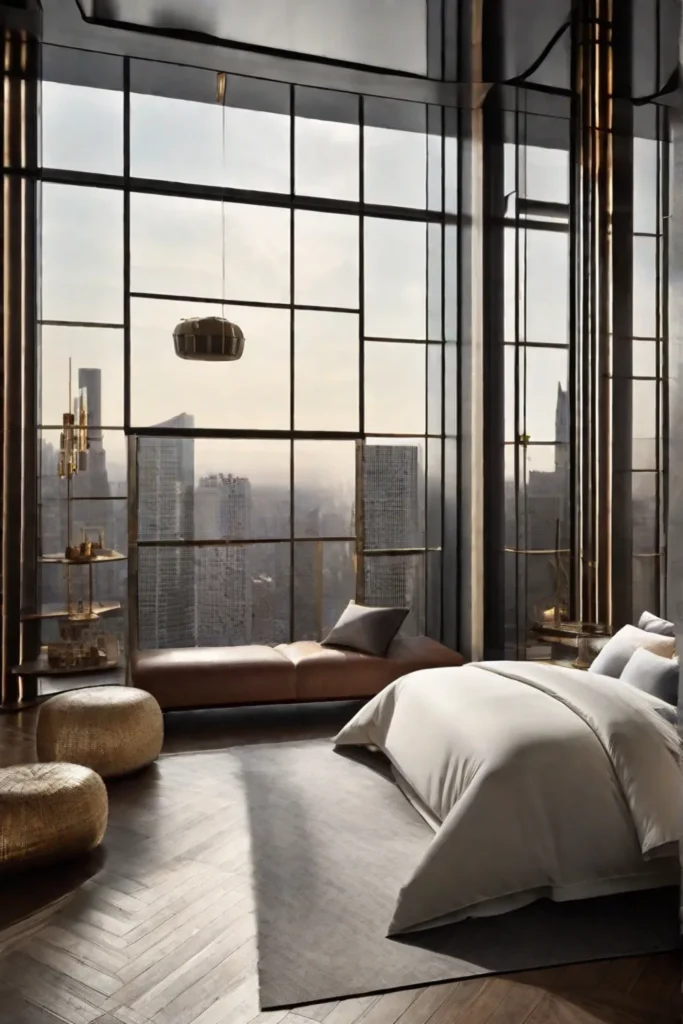Have you ever felt like your tiny bedroom is bursting at the seams? Cramped spaces can leave you feeling suffocated and overwhelmed. But fear not! You can transform your snug sanctuary into a functional, cozy retreat with a few clever furniture tricks.
Imagine waking up in a clutter-free oasis, where every inch is optimized for maximum comfort and efficiency. Implementing these eight essential furniture hacks will unlock the secrets to space-saving bliss. Get ready to embrace the magic of tiny bedrooms!
Multifunctional Furniture: The Cornerstone of a Tiny Bedroom
The average bedroom size in urban areas is a mere 130 square feet. It's even smaller for apartment dwellers – often under 100 square feet. So, how do you make the most of such limited space? The answer lies in multifunctional furniture.
Beds with built-in storage drawers or shelves can provide extra space for clothes, linens, or other belongings, helping keep your room clutter-free and organized. Convertible desks that fold up or down when not in use are perfect for tiny home offices. Ottomans with hidden storage offer extra seating and a place to stash blankets or pillows.

Choosing furniture that serves multiple purposes allows you to maximize every square inch and create a more functional, comfortable environment.
Elevated Beds: Creating Storage Space Below
Every inch counts in space-challenged bedrooms. Elevated or loft beds offer a clever solution by freeing up valuable floor space beneath.
"Vertical space is often overlooked in small bedrooms," says interior designer Emily Henderson. "Elevated beds are a great way to optimize this space and create additional storage or a cozy study area."
The loft bed created enough room for a desk and chair, instantly doubling as a functional study nook.

Additionally, you can place drawers, baskets, or bins under the elevated bed for even more storage. You can also consider incorporating built-in shelves or drawers into the bed frame itself.
Wall-Mounted Desks and Shelves: Maximizing Floor Space
Wall-mounted desks and shelving offer a brilliant solution for maximizing floor space in tiny bedrooms. You can create a more spacious and clutter-free environment by elevating these pieces off the ground. In fact, studies show that wall-mounted furniture can save up to 50% of floor space compared to traditional freestanding pieces.
Installing wall-mounted furniture requires careful attention to safety and aesthetics:
- Ensure you have the appropriate tools and materials, including a stud finder, drill, screws, and anchors.
- Locate wall studs for secure mounting using a stud finder. Measure and mark the exact location for each piece carefully. Use heavy-duty screws and anchors to ensure the furniture is firmly attached to the wall.
- Consider the height and visibility of the furniture to optimize its functionality and visual appeal.

Additionally, you can install floating nightstands, wall-mounted headboards, or vertical storage solutions like shelves, drawers, or pegboards to store items like books, accessories, or clothing.
Opt for Sliding Doors or Curtains for Closets
Traditional hinged closet doors swing outward, occupying valuable floor space. Sliding doors, on the other hand, glide along a track, requiring only a few inches of clearance. Curtains provide an even more compact solution, taking up virtually no floor space.
According to a study by the National Association of Home Builders, hinged closet doors require an average of 3 square feet of floor space, while sliding doors need only 1 square foot. Curtains can save up to 50% more space than sliding doors.
Not only are sliding doors and curtains space-saving, but they also offer a sleek and stylish aesthetic. Sliding doors come in various glass, mirror, and wood finishes, while curtains add softness and warmth to a room. Plus, curtains can be easily changed to match the changing seasons or décor.

For added space-saving benefits, consider mirror or pocket doors that slide into the wall, completely disappearing when open.
Under-Bed Storage: Out of Sight, Yet Accessible
Under-bed storage is a hidden gem for keeping seasonal items and reducing clutter, especially in tiny bedrooms. Utilizing the space beneath your bed allows you to store bulky items without sacrificing valuable floor space.
Rolling storage bins on wheels allow easy access to items without pulling everything out. Vacuum storage bags can dramatically reduce the volume of seasonal items like blankets and pillows. Under-bed drawers provide organized storage for smaller items like socks, underwear, and pajamas.
Hanging or stackable shoe organizers keep shoes tidy and off the floor. Some headboards even feature shelves or drawers for extra storage space.

To maintain order and prevent dust in under-bed storage areas, use clear containers so you can see what's inside without opening every box. Label containers clearly to find items quickly. Regularly vacuum or dust to keep areas clean. Elevate items on risers or small platforms to prevent moisture and dust from reaching them. Also, avoid overcrowding to allow air circulation and prevent mold or mildew.
Mirrors: Creating the Illusion of Space
Mirrors are a classic space-saving hack that can make a tiny bedroom feel instantly larger. By reflecting light and creating the illusion of depth, mirrors can visually expand the confines of a small room.
"Mirrors are an essential tool for maximizing space in small bedrooms," says Dr. Emily Carter, a leading environmental psychologist. "They not only create the illusion of a larger room but also reduce feelings of claustrophobia and enhance the overall ambiance."

For maximum impact, place mirrors opposite windows to reflect natural light and create an open feel. Full-length mirrors reflect the entire room, creating a more expansive effect than smaller mirrors. You can even consider mirrored furniture like nightstands, dressers, or headboards to add to the illusion of space.
Foldable Furniture: Space-Saving Magic
Furniture pieces like Murphy beds, foldable chairs, and collapsible tables are game-changers for tiny bedrooms. They offer a clever solution to the ever-present challenge of optimizing space while maintaining comfort.
According to a survey by the American Society of Interior Designers (ASID), 82% of homeowners with small bedrooms have incorporated foldable furniture into their spaces. The survey also found that 95% of those homeowners reported a significant increase in space and a notable improvement in their overall satisfaction with their bedrooms.
For a simple DIY project, try creating a foldable bedside table. All you need is plywood, wood screws, hinges, and paint or stain (optional). Cut two pieces of plywood into the desired size, and attach them together with wood screws, leaving one side open for the hinge. Install the hinges on the open side, then paint or stain the table as desired. Fold the table down when not in use to save space.

Other space-saving ideas include wall-mounted foldable desks, foldable ottomans that double as seating and storage, or multipurpose foldable furniture like chairs that convert into beds.
Lighting and Color: Enhancing the Perception of Space
Lighting and color can significantly alter the perceived size of a tiny bedroom. Natural light is always preferable, making the room feel larger and brighter. If natural light is limited, artificial lighting can be strategically placed to create the illusion of space.
Uplighting that illuminates walls and ceilings with indirect lighting can draw the eye upward, making the room appear taller. Pendant lights suspended from the ceiling create a sense of height and depth. Recessed lighting in the ceiling provides ambient lighting without taking up valuable floor space.
Color also plays a crucial role in shaping the perception of space. Light colors like white, beige, and pastels reflect light and make the room feel more spacious. Cool colors like blue, green, and purple have a receding effect, making the room appear larger. Warm colors like red, orange, and yellow advance forward, making the room feel smaller – though they can be used as accents to add depth and contrast.

Conclusion: Embrace the Cozy Charm of Tiny Bedrooms
By implementing these eight essential furniture hacks, you can unlock the magic of tiny bedrooms and create a cozy, functional retreat:
- Maximize vertical space with shelves and drawers.
- Choose multifunctional furniture that serves multiple purposes.
- Incorporate floating furniture mounted on walls.
- Utilize under-bed storage for seasonal items and decluttering.
- Foldable and collapsible furniture can be easily stowed away when not in use.
- Keep surfaces clear to create a sense of space and reduce visual clutter.
- Use mirrors to reflect light and create the illusion of a larger space.
- Customize and personalize your space to reflect your unique style and comfort needs.
Remember, creativity and personalization are critical when designing tiny bedrooms. Experiment with different layouts, colors, and textures to create a space that optimizes space and reflects your unique personality.
Share your tiny bedroom transformations or seek further inspiration from our vast articles and resources on Home Decor Chat. Let us help you create a cozy and functional haven in your small space!

